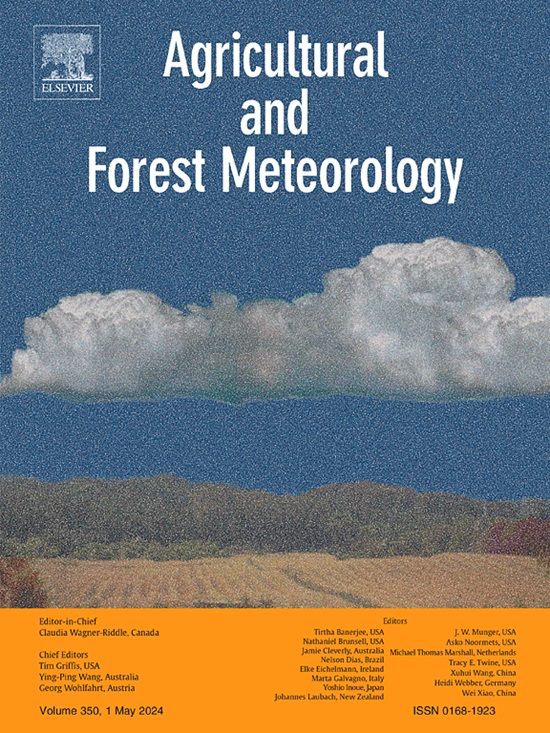Decreasing annual pollen loads in evergreen needleleaf species (Pinaceae) by the earlier end of the spring pollen season
IF 5.7
1区 农林科学
Q1 AGRONOMY
引用次数: 0
Abstract
Globally, the annual pollen integral (APIn) of allergenic plant species has increased owing to climate-induced ecosystem changes; however, the role of phenology in APIn changes remains underexplored. This study examined the direct and indirect effects of climate variables and pollen phenology on APIn in Korean Pinus spp. using 23 years of ground-based data from seven stations. Phenological stages—start (SPS), end (EPS), and length (LPS) of the pollen season—were estimated using two different methods: percentage-based and threshold-based. At the same time, various meteorological indicators related to temperature and precipitation were calculated from daily observation data. Despite interannual warming, APIn significantly declined at most stations by about 2 % per year, independent of temperature trends. Path analysis revealed that temperature sequentially influenced pollen phenology: higher seasonal temperatures advanced SPS (β = –1.19, p < 0.01) and EPS (β = –0.73, p < 0.05), leading to significant indirect reductions in APIn. Bootstrapped mediation models confirmed adverse indirect effects through EPS (β = –204.21) and multi-step paths involving SPS and LPS.
In contrast, early-season rainfall showed limited influence, with a single significant path through EPS (β = 110.90). These findings reveal that phenological advancement can suppress pollen production under favorable climatic conditions. Climate-pollen interactions in coniferous forests are thus better understood through a phenological mediation framework, which captures the cascading effects of shifting seasonal timing. Monitoring phenological change offers a critical tool for predicting ecosystem-level responses to climate change and informing forest management in temperate regions.
春季花粉季节较早结束时,常绿针叶物种(松科)的年花粉负荷下降
在全球范围内,由于气候引起的生态系统变化,致敏植物物种的年花粉积分(APIn)增加;然而,物候在APIn变化中的作用仍未得到充分探讨。利用7个站点23年的地面资料,研究了气候变量和花粉物候对红松APIn的直接和间接影响。物候阶段——花粉季节的开始(SPS)、结束(EPS)和长度(LPS)——采用两种不同的方法进行估算:基于百分比的方法和基于阈值的方法。同时,根据日观测资料计算出与气温、降水有关的各项气象指标。尽管年际变暖,但大多数站点的APIn每年显著下降约2%,与温度趋势无关。通径分析表明,温度对花粉物候的影响依次为:季节温度越高,SPS越早(β = -1.19, p <;0.01)和EPS (β = -0.73, p <;0.05),导致APIn间接显著降低。bootstrap中介模型通过EPS (β = -204.21)和涉及SPS和LPS的多步路径证实了不利的间接效应。相比之下,早季降雨的影响有限,只有一条通过EPS的显著路径(β = 110.90)。这些结果表明,在有利的气候条件下,物候推进可以抑制花粉的产生。因此,通过物候调解框架可以更好地理解针叶林中的气候-花粉相互作用,该框架捕获了季节时间变化的级联效应。监测物候变化是预测温带地区生态系统对气候变化的响应和为森林管理提供信息的重要工具。
本文章由计算机程序翻译,如有差异,请以英文原文为准。
求助全文
约1分钟内获得全文
求助全文
来源期刊
CiteScore
10.30
自引率
9.70%
发文量
415
审稿时长
69 days
期刊介绍:
Agricultural and Forest Meteorology is an international journal for the publication of original articles and reviews on the inter-relationship between meteorology, agriculture, forestry, and natural ecosystems. Emphasis is on basic and applied scientific research relevant to practical problems in the field of plant and soil sciences, ecology and biogeochemistry as affected by weather as well as climate variability and change. Theoretical models should be tested against experimental data. Articles must appeal to an international audience. Special issues devoted to single topics are also published.
Typical topics include canopy micrometeorology (e.g. canopy radiation transfer, turbulence near the ground, evapotranspiration, energy balance, fluxes of trace gases), micrometeorological instrumentation (e.g., sensors for trace gases, flux measurement instruments, radiation measurement techniques), aerobiology (e.g. the dispersion of pollen, spores, insects and pesticides), biometeorology (e.g. the effect of weather and climate on plant distribution, crop yield, water-use efficiency, and plant phenology), forest-fire/weather interactions, and feedbacks from vegetation to weather and the climate system.

 求助内容:
求助内容: 应助结果提醒方式:
应助结果提醒方式:


